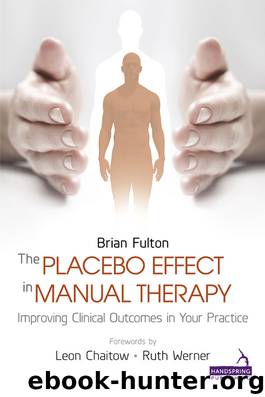The Placebo Effect in Manual Therapy by Brian Fulton & Ruth Werner

Author:Brian Fulton & Ruth Werner [Fulton, Brian]
Language: eng
Format: epub
Publisher: Handspring Pub Ltd
Published: 2015-08-30T21:00:00+00:00
A typical PMR session might go as follows. Make sure that your patient is comfortably supported in a quiet place, then:
•To begin with have them take three deep abdominal breaths, exhaling slowly each time. As they exhale, have them visualize tension flowing out of their body.
•Next have them clench both of their fists. Hold that position for 7–10 seconds and then release for 15–20 seconds.
•As they tense their muscles in each and every area of their body have them notice all of the sensations of tension in that region.
•As they relax, likewise have them explore the wonderful feeling of relaxation throughout that area of their body.
•Use a phrase such as ‘feel the tension in your forearm, leg, etc.’ for each and for every area that you have them create tension.
•Likewise, as you ask them to relax an area, say something like ‘now notice the wonderful feeling of relaxation. Feel how wonderful it is to experience the feeling of relaxation in every cell of your body.’
•Use these same time intervals for all other muscle groups.
•Next have them tighten their forearm muscles, hold and then relax.
•Have them tighten their biceps by drawing their forearms up toward their shoulders and ‘make a muscle’ with both arms. Hold . . . and then relax.
•Have them tighten up their shoulders, then hold . . . and then relax.
•Then have them tighten muscles in the whole region, fists, forearms, biceps and shoulders at the same time.
•Have them tighten all of the muscles in their feet, then hold and relax.
•Then follow through the whole body and don’t forget anything, even muscles of the face, each time doing individual areas, then the whole region.
•Then have them tense up their entire body, holding tension in every imaginable muscle. Then have them relax their entire body and enjoy the feeling of relaxation.
•Then have them scan their body for any residual tension. If a particular area remains tense, repeat one or two tense–relax cycles for that group of muscles.
•Now have them imagine a wave of relaxation slowly spreading throughout their entire body, starting at their head and gradually penetrating every muscle group, all the way down to their toes.
Download
This site does not store any files on its server. We only index and link to content provided by other sites. Please contact the content providers to delete copyright contents if any and email us, we'll remove relevant links or contents immediately.
Periodization Training for Sports by Tudor Bompa(8168)
Why We Sleep: Unlocking the Power of Sleep and Dreams by Matthew Walker(6618)
Paper Towns by Green John(5087)
The Immortal Life of Henrietta Lacks by Rebecca Skloot(4525)
The Sports Rules Book by Human Kinetics(4288)
Dynamic Alignment Through Imagery by Eric Franklin(4115)
ACSM's Complete Guide to Fitness & Health by ACSM(3987)
Kaplan MCAT Organic Chemistry Review: Created for MCAT 2015 (Kaplan Test Prep) by Kaplan(3939)
Introduction to Kinesiology by Shirl J. Hoffman(3720)
Livewired by David Eagleman(3682)
The Death of the Heart by Elizabeth Bowen(3551)
The River of Consciousness by Oliver Sacks(3535)
Alchemy and Alchemists by C. J. S. Thompson(3448)
Bad Pharma by Ben Goldacre(3353)
Descartes' Error by Antonio Damasio(3229)
The Emperor of All Maladies: A Biography of Cancer by Siddhartha Mukherjee(3062)
The Gene: An Intimate History by Siddhartha Mukherjee(3046)
The Fate of Rome: Climate, Disease, and the End of an Empire (The Princeton History of the Ancient World) by Kyle Harper(3003)
Kaplan MCAT Behavioral Sciences Review: Created for MCAT 2015 (Kaplan Test Prep) by Kaplan(2936)
